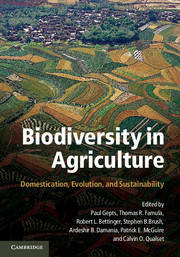Book contents
- Frontmatter
- Contents
- Tables
- Figures
- Foreword
- Contributors
- Acknowledgments
- Introduction: The Domestication of Plants and Animals: Ten Unanswered Questions
- 1 The Local Origins of Domestication
- Section I Early Steps in Agricultural Domestication
- Section II Domestication of Animals and Impacts on Humans
- 9 Pathways to Animal Domestication
- 10 Genetics of Animal Domestication
- 11 Genome-Wide Approaches for the Study of Dog Domestication
- 12 Malaria and Rickets Represent Selective Forces for the Convergent Evolution of Adult Lactase Persistence
- Section III Issues in Plant Domestication
- Section IV Traditional Management of Biodiversity
- Section V Uses of Biodiversity and New and Future Domestications
- Index
- References
12 - Malaria and Rickets Represent Selective Forces for the Convergent Evolution of Adult Lactase Persistence
Published online by Cambridge University Press: 05 June 2012
- Frontmatter
- Contents
- Tables
- Figures
- Foreword
- Contributors
- Acknowledgments
- Introduction: The Domestication of Plants and Animals: Ten Unanswered Questions
- 1 The Local Origins of Domestication
- Section I Early Steps in Agricultural Domestication
- Section II Domestication of Animals and Impacts on Humans
- 9 Pathways to Animal Domestication
- 10 Genetics of Animal Domestication
- 11 Genome-Wide Approaches for the Study of Dog Domestication
- 12 Malaria and Rickets Represent Selective Forces for the Convergent Evolution of Adult Lactase Persistence
- Section III Issues in Plant Domestication
- Section IV Traditional Management of Biodiversity
- Section V Uses of Biodiversity and New and Future Domestications
- Index
- References
Summary
Most of the world's adults cannot drink milk without digestive disturbances because the gut enzyme lactase-phlorizin hydrolase (LPH), responsible for hydrolyzing lactose into easily digestible glucose and galactose, does not persist long after weaning. Notable exceptions to this global generalization are most northern Europeans and certain African and Bedouin pastoralists with high rates of adult lactase persistence (ALP) (Swallow 2003). Accordingly, it is commonly accepted that the high prevalence of ALP in these populations arose rapidly by selection for the LPH encoding gene (LCT) in the 5,000 to 10,000 years since their adoption of dairying (Swallow 2003, Bersaglieri et al. 2004, Tishkoff et al. 2006). Clearly, gene flow from dairying populations with pre-existing high rates of ALP may underlie intermediate ALP frequencies in societies with no history of dairying. Nevertheless, the ability to digest milk is considered an archetypal example of gene-culture co-evolution whereby dairying confers selective benefit to those adults who can drink milk ad libitum without digestive discomfort. The selection coefficient (s) for putative LCT alleles in sub-Saharan Africans (0.035 to 0.097) (Tishkoff et al. 2006), Europeans (0.014 to 0.15) (Bersaglieri et al. 2004), and Scandinavians (0.09 to 0.19) (Bersaglieri et al. 2004) has been labeled: (1) “among the strongest yet seen for any gene in the genome” (Bersaglieri et al. 2004) and (2) “one of the strongest genetic signatures of natural selection yet reported in humans” (Tishkoff et al. 2006).
In Europeans, a single nucleotide polymorphism, C/T-13910, is most frequently related to persistence or nonpersistence of LPH, because presence of the T-13910 allele is highly (86%–98%) associated with ALP (Poulter et al. 2003, Högenauer et al. 2005, Ridefelt and Hakansson 2005) and, in vitro, promotes binding of the LCT transcription factor, Oct-1 (Lewinsky et al. 2005). In contrast, T-13910 is either absent or present at low frequencies (0%–14%) in sub-Saharan African and Bedouin milk-drinking pastoralists with ALP (Mulcare et al. 2004, Ingram et al. 2007). An exception to this general trend is the sub-Saharan Fulani people, who maintain a high incidence of T-13910, likely due to a degree of Caucasian admixture in their gene pool (Enattah et al. 2007). A number of candidate alleles for LCT regulatory mutations in sub-Saharan African pastoralists include G-13907, G-13915, and C-14010 (Tishkoff et al. 2006), although G-13915 abolishes rather than enhances Oct-1 binding (Ingram et al. 2007).
- Type
- Chapter
- Information
- Biodiversity in AgricultureDomestication, Evolution, and Sustainability, pp. 299 - 308Publisher: Cambridge University PressPrint publication year: 2012
References
- 5
- Cited by

